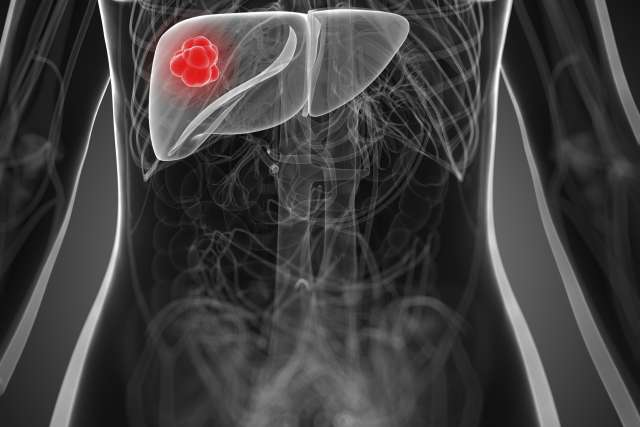Systemic chemotherapy is currently the standard treatment for unresectable metastatic colorectal cancer. However, its lack of tumor specificity and associated high toxicity are significant limitations.
Hepatic arterial infusion chemotherapy (HAIC) delivers targeted high-dose chemotherapy directly into liver tumors with minimal risk of systemic toxicity. It offers treatment options for patients with metastatic colon cancer that would otherwise be unavailable with systemic chemotherapy.
HAIC shows strong promise to improve the current five-year survival rate of about 14%, increase the proportion of patients receiving curative surgical therapy and reduce the incidence of recurrence following curative surgery.
The HAIC program was established to bring more options to patients with metastatic colorectal cancer and to improve their long-term cancer outcomes, according to Vatche G. Agopian, MD, and Sidharth Anand, MD, MBA, both members of the UCLA Health Jonsson Comprehensive Cancer Center.
Dr. Agopian is an Professor of Surgery and Director of the Dumont-UCLA Liver Cancer Center at the David Geffen School of Medicine at UCLA. Dr. Anand is the director of quality improvement in the division of hematology-oncology and serves as the medical director of the HAIC program.
Extending survival and treatment
The surgical oncology and medical oncology teams initiated the HAIC program for select patients with metastatic colon cancer and unresectable intrahepatic cholangiocarcinoma. It is a multidisciplinary effort led by experts from many disciplines, including surgery, nuclear medicine, interventional radiology, and pharmacy.
Dr. Agopian is the surgery lead, involved in surgically placing the pump and preparing patients to receive chemotherapy through hepatic arterial infusion. Dr. Anand, a medical oncologist and hematologist practicing in Santa Monica and Westlake Village, works to manage the chemotherapy process.
The main goal of the program, according to Dr. Agopian, is to bring patients who currently have limited options with systemic chemotherapy and otherwise are not candidates for curative intent resection to downstage their tumors enough to undergo surgical curative therapy.
Another objective is to offer life-prolonging treatment with as few side effects as possible to patients whose disease remains incurable after the therapy.
The team hopes to “use existing data (comparing HAIC benefits with systemic chemotherapy) to give patients a fighting chance of hopefully extending their survival,” says Dr. Anand, “and, in some cases, perhaps even getting to curative resection.”
HAIC in a nutshell
HAIC is a treatment approach that involves delivering targeted cancer-killing therapy through a surgically implanted pump.
“We surgically implant a catheter in the gastroduodenal artery to deliver high-dose chemotherapy directly into the liver via the hepatic artery,” explains Dr. Agopian. The drug used, Floxuridine, has a high first-pass metabolism through the liver, delivering the chemotherapy directly into the tumors at a high dose and reducing systemic toxicity.
This technology makes intuitive sense for more effectively controlling the disease, according to Dr. Anand.
More on colorectal cancer treatment at UCLA Health
Another reason it works is that metastatic lesions often receive their blood supply from the arterial system, says Dr. Agopian. Delivering chemotherapy through the arterial system will more effectively treat the metastatic lesions in the liver.
The data also speaks to its efficacy. Patients receiving this therapy have up to 73% objective response rate in the liver, and many will have enough tumor shrinkage to allow for surgical resection, according to Dr. Agopian.
Even for those who may still not qualify for surgical resection, there is still a greater survival benefit compared to systemic chemotherapy, improving their overall median survival by two years, he adds.
HAIC therapy is appropriate for patients with unresectable metastatic colorectal cancer who do not have metastases outside their liver, and those who can undergo surgical management of their liver but are at higher risk of developing a recurrence, says Dr. Agopian.
The first pump implant case
The program’s first hepatic arterial infusion case involved a female patient with unresectable metastatic colorectal cancer with multiple liver metastases to both the right and left hepatic lobes, says Dr. Agopian. She was on systemic chemotherapy for a few months by the time the program was up and running. Though she had a modest response, it wouldn’t get her to the point of surgical resection, he adds.
The patient received the pump implant on April 28 and started receiving Floxuridine treatment on May 28, according to Dr. Agopian.
The patient will receive infusional chemotherapy with Floxuridine directly to her pump every month for a few months. After this, she will undergo restaging scans to determine if her liver metastases are responding to treatment. If they are, she will be considered for liver resection, Dr. Anand explains. Otherwise, she will continue her pump treatment until she is eligible for surgery.
Speaking on the future of pump implants, Dr. Agopian mentions the possibility of robotic implantation in a minimally invasive manner, requiring only a few incisions and a pump pocket in future cases. He believes this approach could make the procedure more appealing to patients, allow for faster recovery and earlier initiation of therapy.






